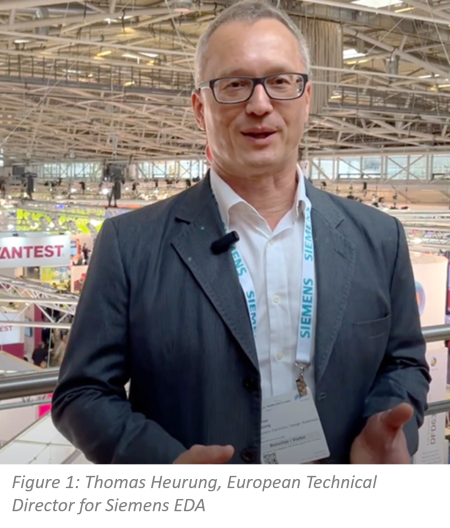At EDA Solutions, we’ve always believed in the power of collaboration, innovation and strategic foresight. That belief was reinforced during our recent company meeting, where we had the privilege of hosting Thomas Heurung, European Technical Director for Siemens EDA. This article reflects Siemens’ vision which Thomas shared with our team of the future of electronic design automation (EDA), with insights that are not only ambitious but deeply relevant to the evolving European semiconductor landscape.
Xcelerator: A Unified Vision Across Siemens
At the heart of Siemens’ strategy is the Xcelerator platform—a digital twin framework that spans across Siemens’ diverse business units, from factory automation to EDA. This isn’t just branding; it’s a commitment to creating a unified, interoperable ecosystem where software-defined, silicon-enabled, AI-powered systems can be designed, verified and deployed with unprecedented efficiency.
Thomas highlighted how this vision is being embraced across Siemens AG, with real traction in both internal operations and customer-facing solutions. For EDA Solutions and our customers, this means tighter integration between design tools, simulation platforms and manufacturing workflows—ultimately reducing time-to-market and improving product reliability.
Strategic Acquisitions Driving Innovation
Siemens’ recent acquisitions—including Altair, Exelicon and Downstream—are expanding the capabilities of the EDA portfolio. Altair, in particular, brings powerful simulation and AI-driven product development tools that complement Siemens’ existing strengths in PLM (Product Lifecycle Management) and digital twin technologies.
These acquisitions are more than just portfolio expansion—they’re about enabling model-based systems engineering, where high-level requirements can be translated into hardware and software specifications with traceability and precision. For European start-ups and SMEs, this opens the door to more agile development cycles and better alignment with customer needs.
The Rise of Purpose-Built Silicon
One of the most compelling trends Thomas discussed is the shift toward purpose-built silicon. Driven by the demands of AI, edge computing and hyperscale data centres, companies are increasingly designing their own chips to optimize performance, power and cost.

This trend is particularly relevant in Europe, where the CHIPS Act and national initiatives are encouraging local innovation. Siemens’ tools are already supporting this movement, enabling companies to explore new architectures, validate designs earlier and reduce risk through emulation and prototyping.
3D IC and Heterogeneous Integration: The Next Frontier
While 3D IC adoption is currently led by hyperscalers, Thomas noted growing interest in heterogeneous integration—especially in Europe. Imaging, MEMS and power management ICs are increasingly being designed using multiple technologies and Siemens is actively developing tools to support this complexity.
EDA Solutions is already seeing inquiries from customers exploring 3D IC and chiplet-based designs. With Siemens’ roadmap aligning to these needs, we’re excited to help our customers navigate this next wave of innovation.
RISC-V and the Democratization of Digital Design
Thomas also addressed the growing momentum behind RISC-V, particularly among European start-ups. While Arm remains a key partner for Siemens EDA, the flexibility and openness of RISC-V are attracting attention from companies seeking to differentiate their products.
Siemens EDA solutions—including simulation, verification and IP integration—are well-positioned to support RISC-V development.
What This Means for Our Customers
Siemens’ vision is bold, but it’s grounded in practical benefits for our customers:
- Faster time-to-market through integrated digital twin workflows
- Lower development risk via early software validation and emulation
- Greater design flexibility with support for emerging architectures and standards
- Scalable innovation through cloud-based tools and load-balanced simulation
At EDA Solutions, we’re proud to be part of this journey. Whether you’re a start-up building your first ASIC or an established company exploring new design methodologies, EDA Solutions—offers the custom IC design solutions, expertise and support to help you succeed.
Let’s build the future of European microelectronics together.
